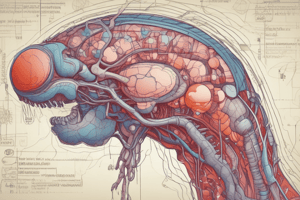Podcast
Questions and Answers
Which of the following hormones has a lesser role in calcium regulation compared to parathyroid hormone?
Which of the following hormones has a lesser role in calcium regulation compared to parathyroid hormone?
- Parathyroid hormone
- Calcitriol
- Vitamin D
- Calcitonin (correct)
What is the primary function of osteoblasts in bone structure and function?
What is the primary function of osteoblasts in bone structure and function?
- Producing calcitriol
- Regulating calcium levels
- Breaking down bone
- Building bone (correct)
Which of the following is NOT a target of parathyroid hormone?
Which of the following is NOT a target of parathyroid hormone?
- Bone
- Kidneys
- Liver (correct)
- GI Tract
What is the effect of calcitriol on the parathyroid gland?
What is the effect of calcitriol on the parathyroid gland?
What is the role of RANK ligand in bone structure and function?
What is the role of RANK ligand in bone structure and function?
What is the primary function of phosphate in the body?
What is the primary function of phosphate in the body?
Which of the following is a function of calcitonin?
Which of the following is a function of calcitonin?
What is the effect of parathyroid hormone on osteoblasts?
What is the effect of parathyroid hormone on osteoblasts?
Which of the following is NOT a target of calcitriol?
Which of the following is NOT a target of calcitriol?
What is the role of Macrophage Colony Stimulating Factor (M-CSF) in bone structure and function?
What is the role of Macrophage Colony Stimulating Factor (M-CSF) in bone structure and function?
Study Notes
Endocrinology: Calcium and Phosphate Regulation
Importance of Calcium and Phosphate
- Calcium is essential for muscle contraction and nerve conduction
- Phosphate is crucial for biochemical processes and energy production
- Regulation of calcium and phosphate levels is necessary for proper bodily functions
Hormones Involved
- Vitamin D (active form: calcitriol)
- Parathyroid hormone
- Calcitonin
Parathyroid Hormone
- Released when plasma calcium levels decrease
- Targets:
- Bone: stimulates breakdown, releasing calcium and phosphate into plasma
- Kidneys: activates enzyme 1-alpha hydroxylase, converting vitamin D to calcitriol
- Increases calcium and phosphate levels in plasma
Calcitriol (Active Form of Vitamin D)
- Converts vitamin D to active form
- Targets:
- Bone: stimulates breakdown, releasing calcium and phosphate into plasma
- Kidneys: stimulates reabsorption of calcium in proximal convoluted tubules
- GI Tract: increases calcium and phosphate absorption
- Negatively feedbacks on parathyroid gland, reducing parathyroid hormone production
Calcitonin
- Released when plasma calcium levels increase
- Decreases plasma calcium levels
- Has a lesser role in calcium regulation compared to parathyroid hormone
Bone Structure and Function
- Composed of osteoblasts (build bone) and osteoclasts (break down bone)
- Osteoblasts have parathyroid hormone receptors, which induce:
- Proliferation
- RANK ligand expression
- Inhibition of osteoprotegerin production
- RANK ligand binding to RANK receptors on pre-osteoclasts induces:
- Proliferation
- Differentiation into active osteoclasts
- Macrophage Colony Stimulating Factor (M-CSF) also stimulates osteoclast proliferation and differentiation
Calcium and Phosphate Regulation
Importance of Calcium and Phosphate
- Calcium is essential for muscle contraction and nerve conduction
- Phosphate is crucial for biochemical processes and energy production
- Regulation of calcium and phosphate levels is necessary for proper bodily functions
Hormones Involved in Calcium and Phosphate Regulation
- Vitamin D (active form: calcitriol)
- Parathyroid hormone
- Calcitonin
Parathyroid Hormone
- Released when plasma calcium levels decrease
- Stimulates bone breakdown, releasing calcium and phosphate into plasma
- Activates enzyme 1-alpha hydroxylase, converting vitamin D to calcitriol in kidneys
- Increases calcium and phosphate levels in plasma
Calcitriol (Active Form of Vitamin D)
- Converts vitamin D to active form
- Stimulates bone breakdown, releasing calcium and phosphate into plasma
- Stimulates calcium reabsorption in kidney proximal convoluted tubules
- Increases calcium and phosphate absorption in GI tract
- Negatively feedbacks on parathyroid gland, reducing parathyroid hormone production
Calcitonin
- Released when plasma calcium levels increase
- Decreases plasma calcium levels
Bone Structure and Function
- Composed of osteoblasts (build bone) and osteoclasts (break down bone)
- Osteoblasts have parathyroid hormone receptors, inducing:
- Proliferation
- RANK ligand expression
- Inhibition of osteoprotegerin production
- RANK ligand binding to RANK receptors on pre-osteoclasts induces:
- Proliferation
- Differentiation into active osteoclasts
- Macrophage Colony Stimulating Factor (M-CSF) stimulates osteoclast proliferation and differentiation
Studying That Suits You
Use AI to generate personalized quizzes and flashcards to suit your learning preferences.
Description
Learn about the importance of calcium and phosphate in the body, and how they are regulated by hormones like vitamin D, parathyroid hormone, and calcitonin.




